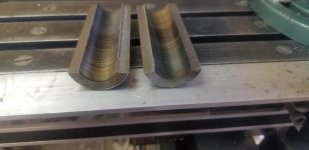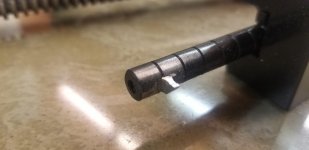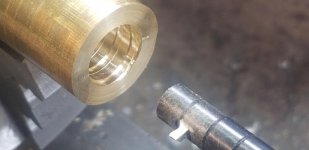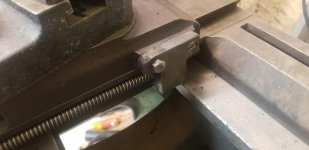mega arc 5040dd
Aluminum
- Joined
- Apr 17, 2012
- Location
- Saskatchewan, Canada
After letting my lathe project sit for the last couple years I figured now was a good time to get going on it again. It is a Macgregor Gourlay lathe from 1885-1910. Where I stopped a couple years ago was trying to figure out how I wanted to repair the cross feed nut. The nut is a cast iron piece that bolts on the side of the cross slide for easy removal. The catch is the original threads were poured babbitt and had long since given up the ghost. the bit of babbitt that remained just slid in and out of the cast iron piece.
The first solution I had the last time I worked on it was to save the babbitt and try and get some more to add to it. So I put the babbitt piece somewhere safe and life went on. Fast forward to 2 weeks ago and I am picking up where I left off and wouldn't you know it after a year or two that babbitt is still in a safe place. So safe that even after ripping my shop apart I can't find it. So then it was time to come up with a plan B. Given that everything is shut down for who knows how long sourcing some locally just wasn't an option. And after looking online neither was that. So I started thinking what else could I do. What happened over the fallowing couple weeks turned out to be the most round about way one could possibly take to get to a solution.
Plan B
This is where my logic and train of thoughts goes out the window. I have a piece of ductile cast iron laying around so figured I would make a new nut. except for two problems 1) The piece of cast iron is only big enough for the threaded portion and would have to be attached to the lest of the mounting bracket I figured either by fasteners or brazing. Ok that problem is easy enough in theory. 2) The cross feed screw is 11/16', square thread, 6 threads per inch, left hand. and being over 100 years old a bit worn in parts though to be honest for the age its not as bad as I would have expected.Now this is where my thinking takes turn and takes me on a trip. I don't know how I am going to thread it and I don't have very much cast iron. Maybe enough for two attempts. since it's 11/16" I decide my only shot it to tap the threads but as you can imagine finding that tap was impossible. I can find on ebay 5/8" left hand acme and so I start to think maybe I can just make a new cross feed screw as well. That's it! It's a great idea. So that's what I thought I would set out to do.But since I don't know how well its going to pan out and given the state of the world I don't want to spend much.
I start looking around and was able to find a piece of 3/4" 4140 locally that was within my tiny budget. Then onto ebay where I just couldn't bring my self to spend that kind of money on a tap that I will use once. And that's when great idea number to comes to me and the land slide of events begins. Why can't I just make my own tap? I've seen videos on youtube. I can thread on my little 10" lathe and really that looks like the hardest part. I don't have any tool steel but I have extra 4140. I know that's a bad choice of material but it's what I have and it's only tapping one hole in cast iron. I'm sure there is a flaw here but my logic was I should do the male thread first since I can measure it easier and then make the tap to fit. I was forgetting that the treads on the tap were external also. Had i remembered things may have gone differently. I go to start making the new cross feed screw and realised it was to long for my 10" lathe. This is when I get yet another bright idea. If I could temporarily fix the cross feed nut on the big lath I could use it to turn its own new screw.
Now that I am full 180 back to trying to fix the original cross feed nut completely forgetting that I abandoned that idea before for a reason. Now how to fix it I know! I can make a tap foe the square threads after all that's how I was solving the self made problem for the acme thread. But before I do that since material is so limited (by this point I think I am allotting the same material over and over again) I should do a practice run. I know I have a 7/8" grade 5 bolt, I can make a practice tap out of that and I can tap some treads into some aluminium. So I start machining the bolt. I found a HSS toll bit in my collection that needed just a little clearance ground onto it and then it was perfect. I then took it to the mill and used an end mill to put a square drive end on it and then a ball nose end mill to put in the flutes and then back to the lathe to taper it. I tapered it at 2degrees not knowing that I should have spread it out over multiple taps if I actually wanted it to work. I then heated it with the torch and then quenched it. success it was harder than my files. I then heated it and tempered it. This is when perfection became the enemy of good enough. something I am bad for is never know when good enough is good enough. I wasn't happy with the temper and thought it was softer than I would have liked. No biggy I though I will just harden it again and then temper it again. But the second time around it developed a case of banana envy and decided to develop a nice healthy curve to it as well as a good sized crack because why stop at just a curve when striving for prefection. I decided to temper it anyway and sharpen it up and at least see it it would cut aluminium. much to my demise I learned that a thread that big and coarse when doen with a single tap is just a different looking reamer
I know! I can make a tap foe the square threads after all that's how I was solving the self made problem for the acme thread. But before I do that since material is so limited (by this point I think I am allotting the same material over and over again) I should do a practice run. I know I have a 7/8" grade 5 bolt, I can make a practice tap out of that and I can tap some treads into some aluminium. So I start machining the bolt. I found a HSS toll bit in my collection that needed just a little clearance ground onto it and then it was perfect. I then took it to the mill and used an end mill to put a square drive end on it and then a ball nose end mill to put in the flutes and then back to the lathe to taper it. I tapered it at 2degrees not knowing that I should have spread it out over multiple taps if I actually wanted it to work. I then heated it with the torch and then quenched it. success it was harder than my files. I then heated it and tempered it. This is when perfection became the enemy of good enough. something I am bad for is never know when good enough is good enough. I wasn't happy with the temper and thought it was softer than I would have liked. No biggy I though I will just harden it again and then temper it again. But the second time around it developed a case of banana envy and decided to develop a nice healthy curve to it as well as a good sized crack because why stop at just a curve when striving for prefection. I decided to temper it anyway and sharpen it up and at least see it it would cut aluminium. much to my demise I learned that a thread that big and coarse when doen with a single tap is just a different looking reamer
 Ok a tap isn't quit as easy as cutting a thread and a few flutes.
Ok a tap isn't quit as easy as cutting a thread and a few flutes.
Not to be discouraged I went straight back to the drawing board to come up with plan C...or is it D now, maybe I'm on F. Anyways I will put that in part 2.
The first solution I had the last time I worked on it was to save the babbitt and try and get some more to add to it. So I put the babbitt piece somewhere safe and life went on. Fast forward to 2 weeks ago and I am picking up where I left off and wouldn't you know it after a year or two that babbitt is still in a safe place. So safe that even after ripping my shop apart I can't find it. So then it was time to come up with a plan B. Given that everything is shut down for who knows how long sourcing some locally just wasn't an option. And after looking online neither was that. So I started thinking what else could I do. What happened over the fallowing couple weeks turned out to be the most round about way one could possibly take to get to a solution.
Plan B
This is where my logic and train of thoughts goes out the window. I have a piece of ductile cast iron laying around so figured I would make a new nut. except for two problems 1) The piece of cast iron is only big enough for the threaded portion and would have to be attached to the lest of the mounting bracket I figured either by fasteners or brazing. Ok that problem is easy enough in theory. 2) The cross feed screw is 11/16', square thread, 6 threads per inch, left hand. and being over 100 years old a bit worn in parts though to be honest for the age its not as bad as I would have expected.Now this is where my thinking takes turn and takes me on a trip. I don't know how I am going to thread it and I don't have very much cast iron. Maybe enough for two attempts. since it's 11/16" I decide my only shot it to tap the threads but as you can imagine finding that tap was impossible. I can find on ebay 5/8" left hand acme and so I start to think maybe I can just make a new cross feed screw as well. That's it! It's a great idea. So that's what I thought I would set out to do.But since I don't know how well its going to pan out and given the state of the world I don't want to spend much.
I start looking around and was able to find a piece of 3/4" 4140 locally that was within my tiny budget. Then onto ebay where I just couldn't bring my self to spend that kind of money on a tap that I will use once. And that's when great idea number to comes to me and the land slide of events begins. Why can't I just make my own tap? I've seen videos on youtube. I can thread on my little 10" lathe and really that looks like the hardest part. I don't have any tool steel but I have extra 4140. I know that's a bad choice of material but it's what I have and it's only tapping one hole in cast iron. I'm sure there is a flaw here but my logic was I should do the male thread first since I can measure it easier and then make the tap to fit. I was forgetting that the treads on the tap were external also. Had i remembered things may have gone differently. I go to start making the new cross feed screw and realised it was to long for my 10" lathe. This is when I get yet another bright idea. If I could temporarily fix the cross feed nut on the big lath I could use it to turn its own new screw.
Now that I am full 180 back to trying to fix the original cross feed nut completely forgetting that I abandoned that idea before for a reason. Now how to fix it
 I know! I can make a tap foe the square threads after all that's how I was solving the self made problem for the acme thread. But before I do that since material is so limited (by this point I think I am allotting the same material over and over again) I should do a practice run. I know I have a 7/8" grade 5 bolt, I can make a practice tap out of that and I can tap some treads into some aluminium. So I start machining the bolt. I found a HSS toll bit in my collection that needed just a little clearance ground onto it and then it was perfect. I then took it to the mill and used an end mill to put a square drive end on it and then a ball nose end mill to put in the flutes and then back to the lathe to taper it. I tapered it at 2degrees not knowing that I should have spread it out over multiple taps if I actually wanted it to work. I then heated it with the torch and then quenched it. success it was harder than my files. I then heated it and tempered it. This is when perfection became the enemy of good enough. something I am bad for is never know when good enough is good enough. I wasn't happy with the temper and thought it was softer than I would have liked. No biggy I though I will just harden it again and then temper it again. But the second time around it developed a case of banana envy and decided to develop a nice healthy curve to it as well as a good sized crack because why stop at just a curve when striving for prefection. I decided to temper it anyway and sharpen it up and at least see it it would cut aluminium. much to my demise I learned that a thread that big and coarse when doen with a single tap is just a different looking reamer
I know! I can make a tap foe the square threads after all that's how I was solving the self made problem for the acme thread. But before I do that since material is so limited (by this point I think I am allotting the same material over and over again) I should do a practice run. I know I have a 7/8" grade 5 bolt, I can make a practice tap out of that and I can tap some treads into some aluminium. So I start machining the bolt. I found a HSS toll bit in my collection that needed just a little clearance ground onto it and then it was perfect. I then took it to the mill and used an end mill to put a square drive end on it and then a ball nose end mill to put in the flutes and then back to the lathe to taper it. I tapered it at 2degrees not knowing that I should have spread it out over multiple taps if I actually wanted it to work. I then heated it with the torch and then quenched it. success it was harder than my files. I then heated it and tempered it. This is when perfection became the enemy of good enough. something I am bad for is never know when good enough is good enough. I wasn't happy with the temper and thought it was softer than I would have liked. No biggy I though I will just harden it again and then temper it again. But the second time around it developed a case of banana envy and decided to develop a nice healthy curve to it as well as a good sized crack because why stop at just a curve when striving for prefection. I decided to temper it anyway and sharpen it up and at least see it it would cut aluminium. much to my demise I learned that a thread that big and coarse when doen with a single tap is just a different looking reamer
 Ok a tap isn't quit as easy as cutting a thread and a few flutes.
Ok a tap isn't quit as easy as cutting a thread and a few flutes.Not to be discouraged I went straight back to the drawing board to come up with plan C...or is it D now, maybe I'm on F. Anyways I will put that in part 2.



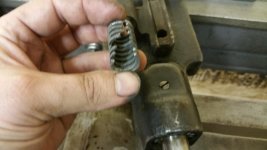
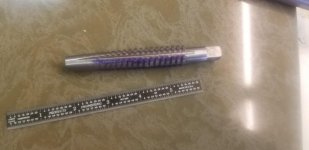

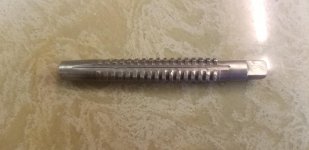

 I could only take .002"-.003" at per cut and then about 5 spring passes after every time I adjusted the cut deeper. I lost count of how many passes before i was at depth but it was hours of threading, and not all at once it had to break it up over several sessions. And then it was the moment of truth all i had to do was move the tool and thread in the screw and it would be proven a success. Stories about my small bore threading would ring out through the ages. I would go on the tell generations that it was easy just needed patients. Nope dam tail stock is in the way. Ok remove that and then I'm all set. Nope notta not even starting
I could only take .002"-.003" at per cut and then about 5 spring passes after every time I adjusted the cut deeper. I lost count of how many passes before i was at depth but it was hours of threading, and not all at once it had to break it up over several sessions. And then it was the moment of truth all i had to do was move the tool and thread in the screw and it would be proven a success. Stories about my small bore threading would ring out through the ages. I would go on the tell generations that it was easy just needed patients. Nope dam tail stock is in the way. Ok remove that and then I'm all set. Nope notta not even starting  well by the time the thick plumbing solder was melting I managed to meld a small hole in the side of the brass where the original babbitt fill hole was
well by the time the thick plumbing solder was melting I managed to meld a small hole in the side of the brass where the original babbitt fill hole was  it actually worked on the second go around its locked it in there really good. I cleaned it up with a wire brushing and then bolted it on the machine. The cross slide moves by cranking the handle for the first time in years. I rand the cross feed all the way in until the nut hits the back of the sadle (it's on the side not underneath) and then tried to see if I could turn the handle and pop the threaded insert loose but it was a no go. It's in there nice and strong.
it actually worked on the second go around its locked it in there really good. I cleaned it up with a wire brushing and then bolted it on the machine. The cross slide moves by cranking the handle for the first time in years. I rand the cross feed all the way in until the nut hits the back of the sadle (it's on the side not underneath) and then tried to see if I could turn the handle and pop the threaded insert loose but it was a no go. It's in there nice and strong.


